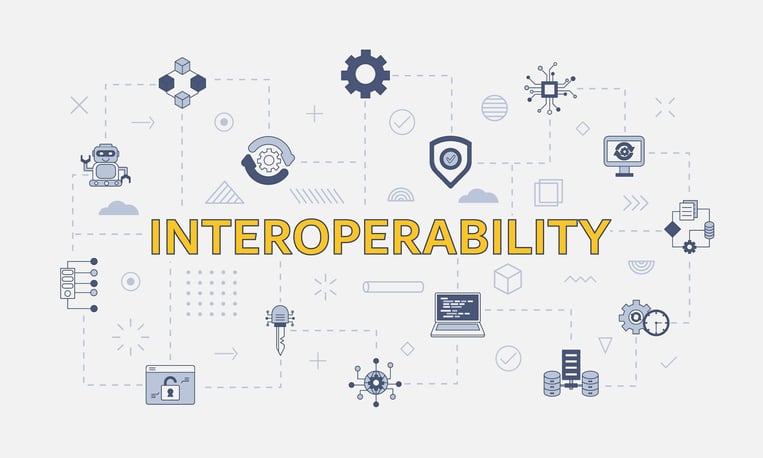
Construction is an oftentimes complicated process that requires as much orchestration and finesse as a well-rehearsed symphony. For example, according to analysis from the National Association of Home Builders, (1) the average new home uses 24 different subcontractors with 84% of construction costs in the typical home stemming from subcontracting. “Subcontracting is extremely pervasive and economically significant in the home building industry,” the study concludes. “[M]aintaining relationships with [subcontractors], and being able to schedule a relatively large number of them to complete projects on time while maintaining control over quality […] is a substantial challenge and an important part of being a successful home builder.”
Despite these inherent constraints, the industry is plagued by mounting concerns, like too few workers. What’s worse, among these overloaded workers in the industry, research by SmartSheet found that 40% spend at least a quarter of their workweek doing tedious and repetitive tasks such as email, data collection, and data entry, while 60% estimated that construction automation could save them six or more hours a week.
Companies do adopt the use of mobile devices with mobile apps to automate in-field processes like daily reporting (62.4%), time management (57.3%) safety management (49.1%), plan management (43.8%), BIM file viewing (32.4%), tool tracking (26.1%), and drone management (10.4%), according to JBKnowledge’s ConTech Report (2). What’s more, 85.1% reported that mobile integrations were an “important” or “very important” factor when purchasing software.
We’ve previously talked about the importance of integrated vs specialized construction software. In an industry that must carefully walk a tightline as mounting weight (like workforce concerns) can, at any moment, throw off an organization’s equilibrium, closed off systems can be the bloat where miscommunication causes careful balance to come crashing down.
In this article, we define an important, related term—Interoperability—what it is, why it’s important to business owners, how it differs from similar terminology (like software integration), and how you can build interoperability into your construction business to drive better outcomes.
Jump Ahead:
Software Interoperability Definition: What Is Software Interoperability?
Broadly, interoperability, (pronounced inter-op-er-ability), defined by Meriam Webster, refers to the “ability” of the “system” (or the organization, company, or tools they use) to “work with or use parts of equipment of another system.”

Within networked computers, an “interoperable” system is one in which each connected computer or interconnected system communicates seamlessly with one another—where data flows directly between systems in real-time.
Like its name suggests, interoperability, in its simplest explanation, refers to the ability of a system to interlay information in order to operate, system wide.
Software interoperability, more specifically, refers to the ability for multiple software programs or systems to work interchangeably and, in effect, synchronize and share data resources in real-time.
Why Is Interoperability Important in Software?
Just as other types of interoperability are important to ensuring there are interoperability standards for how various law enforcement agencies are able to coordinate their efforts to bringing criminals to justice, or how our military and government agencies can work in a coordinated fashion to keep Americans safe, interoperability in software is important for standardizing how data is stored, shared, and regulated, introducing important measures and mechanisms that can remove certain bottlenecks while increasing productivity.

Benefits of software interoperability include:
- Increased efficiency between systems exchanging data in real-time and reducing manual entry.
- Improved collaboration between teams, departments, and vendors via data sharing standardization.
- Greater flexibility via limited compatibility issues and correspondingly improved customer experience via more robust customer relationship management (CRM) that can provide more personalized experiences through customer data.
- Cost savings through standardization and moving away from custom, costly proprietary software programs.
In construction, what’s more, interoperability can be applied to help create the standards that businesses and the entire industry can adopt to improve construction safety measures, zoning, workforce management and training, and more.
What Is Software Integration vs Interoperability?
The interoperability vs integration question, particularly among software and apps, is a common one that comes up and generates some confusion as these two (albeit related) concepts have different meanings in practice.

For example, you may hear a concept like “cross-domain interoperability” and think, “Wouldn’t that refer to app integrations?”
In short, cross-domain interoperability requires there to be common understanding and agreements on both sides of a “domain boundary” (i.e., both domains, both software providers, etc.). When changes are made within the larger community, both sides agree to accept and enforce the use of a domain-wide or worldwide standard and interface protocols such that both sides will be operable with each other. In integrated “systems-of-systems” environments, on the other hand, a single domain or authority (e.g., site operator, software developer, etc.) may control their respective interface used between domains.
The difference between software interoperability and software integration is a little fuzzy with blurring lines, as the concepts are closely related. However, the differences, albeit minute, are existent:
- Software interoperability largely deals with facilitating the seamless, real-time exchange of data and intercommunication of two or more disparate software systems. At the highest level, you might think of interoperability as the protocols enforced by these systems in order to make the data transfer possible between these systems – in other words, the protocols that make the systems themselves communicate behind the scenes. Software integration, while similar, is generally felt more from the user perspective—focusing on combining multiple systems into a single source of truth that makes the use of this data exchange valuable to end users themselves. This single system, or application, is typically achieved through Application Programming Interfaces (aka: API), so that these disparate systems can be better combined into a more unified, cohesive “tech stack” easily usable for teams across the organization.
Further, Bobby Roberts Senior Vice President of Development for Surgical Information Systems, clarifies: “Interoperability is real-time data exchange between […] systems without middleware [and refers to] the ability to not only share information but [also] to interpret incoming data and present it as it was received, preserving its original context” (11).
Types of Interoperability
There are at least a few agreed-upon types of interoperability—such as syntactic interoperability, referring to two systems that communicate with each other, and cross-domain interoperability, which refers to when “different domains interact in information exchange, services, and/or goods to achieve their own or common goals.”
For example, TokenEx, a cloud-based data security company, believes there are generally 3 types of interoperability, (3) syntactic, structural, and semantic, which they define are as follows:
- “Syntactic Interoperability,” they describe, refers to when “two or more systems can communicate and share data, thus allowing different types of software to work together […] even if the interface or language is not the same.”
- “Structural Interoperability,” they continue, refers to the “data exchange format” that “specifies the standards used to format messages sent from one system to another” and essential for users to comprehend “the information’s purpose clearly.”
- Semantic Interoperability,” they conclude, refers to “two or more systems [connecting and sharing] data that each system understands in a meaningful way.”
Meanwhile, Wolters Kluwer, a Dutch information services company describes “3 levels of interoperability” (17) as:
- “Foundational Interoperability,” which “lets the data transmitted by one system to be received by another [without requiring] the system on the receiving end of the transmission to interpret the data,” or the “base of a communications pyramid, offering the most basic of data exchange services.”
- “Structural Interoperability,” the “middle layer,” or “the packaging of the data via message format standards.”
- “Semantic Interoperability,” or “the top of the communications pyramid,” where “systems [can] exchange and use the information that has been transmitted,” where “the structured message contains standardized, coded data” that the system can interpret. Semantic interoperability, they add, “is critical for bridging the terminology gap among divergent […] systems and data sources […] to create a common vocabulary that enables accurate and reliable machine-to-machine communication.”
Further (and perhaps more formally), the European Commission of the European Union describes (15) “6 layers of interoperability:”
- Interoperability Governance
- Integrated Public Service Governance
- Legal Interoperability
- Organizational Operability
- Semantic Interoperability
- Technical Interoperability
Other honorable mentions include:
- System Interoperability (6)
- Organizational Interoperability (7)
- Process Interoperability (8)
- Technical Interoperability (4;8)
- Functional Interoperability (4)
- Subsystem Interoperability, Domestic Interoperability, Cross-Border Interoperability (7)
Brief History of Interoperability & Examples
As presented in 2010 for a workshop for the FDA regarding medical device interoperability, (12) healthcare IT consultant Michael Robkin notes the perhaps earliest reference to the concept of interoperability dates back to the ancient Greek poem, Homer’s Iliad, (5) where Chimera, a mythic monster features a lion's head, a goat's body, and a serpent's tail and breathes fire – a mythic power that is not a capability of the individual components.

Pictured above: Chimera from Homer's Iliad. Image source: Wiki Commons
The term ‘interoperability,’ Robkin goes on, exploded in frequency in online web searches between the late 90s and late 2000s.
In 2004, President Bush established the Office of the National Coordinator for Health Information Technology (ONC) to oversee the development and implementation of health information technology (HIT) policies and programs (8).
The Health Information Technology for Economic and Clinical Health (HITECH) Act was passed as part of the larger American Recovery and Reinvestment Act of 2009 and, in 2011, the meaningful use (MU) component was implemented to expand the adoption of Health Information Technology (HIT) and enable the use of electronic health records (EHRs). However, “A giant advancement in healthcare data interoperability can be traced back to the 1990s,” Jim Tate for Health IT Answers points out, (16) back when EHRs became more widespread and, more critically, when “Early EHR systems were often proprietary and not designed to share data with other systems, leading to the development of data exchange standards and initiatives aimed at improving interoperability.”

Other examples of problems with interoperability include a court case (9) brought by the European Commission of the European Union (EU) against Microsoft for abuse of “its dominant position in the market” that resulted in the EU ordering Microsoft to divulge certain information about its server products and release a version of Microsoft Windows without Windows Media Player specifically focused on the interoperability issue. More recent examples include the adoption of the more standard USB-C electronic connector system that is putting pressure on Apple to switch from their proprietary “lightening cable” lest face regulatory intervention.
Examples of Interoperability
Examples of Interoperability have long existed in plain sight:
- Interlibrary Loan (aka: ILL) is a service that enables patrons of one library to borrow physical materials and receive electronic documents that are held by another library. The International Organization of Standardization (ISO) established standards, ISO 10160 and ISO 0161, in 1993 to standardize terminology and define a set of communication protocols between various interlibrary loan systems, and allowing for interoperability across platforms.
- Railways across the world abide by operating rules that enhance safety, just as air traffic has regulations and policies put forth by the Federal Aviation Administration (FAA).
- Flood risk management (FRM) aims to “[assess] the complex properties of urban infrastructure systems, particularly the interoperability between the drainage systems and other urban systems (e.g. infrastructure such as transport)” In order to “expand the capacity of the overall system to manage flood water towards achieving improved urban flood resilience.”
- Military Forces: The North Atlantic Treaty Organization (aka: NATO) (10) “defines interoperability for their purposes as “the ability for Allies to act together coherently, effectively and efficiently to achieve tactical, operational and strategic objectives.” Interoperability, they explain, enables “forces, units and/or systems to operate together, allowing them to communicate and to share common doctrine and procedures, along with each other’s infrastructure and bases,” adding “Interoperability reduces duplication, enables pooling of resources and produces synergies among all Allies, and whenever possible with partner countries.”
- Public Safety: First responders—from police to medical personnel to firefighters—rely on interoperability to share critical information with each other in real-time.
Software Interoperability Examples
Within software, the term “interoperability” refers to the ability for different programs to exchange data through “a common set of exchange formats” in order to “read and write the same file formats, and to use the same protocols.” Common software interoperability problems include concepts like device fragmentation.
Software interoperability examples include:
- Web Browsers, where, for example, major browsers like Google Chrome, Mozilla Firefox, and Microsoft Edge are designed to be compatible with a wide range of web technologies from HTML and CSS to JavaScript.
- Email Clients are designed to work with various email servers, allowing, for example, you to set up your email in both Microsoft Outlook and/or Apple Mail, on multiple devices. This is how you get your messages and can fire off an email from your preferred platform on your preferred device while also assuring your messages will appear when switching devices.
- Cloud-Based Storage and Systems: Just as DropBox, Google Drive, or Microsoft OneDrive/SharePoint all allow you to seamlessly share files wherever you are, the ONE-KEY™ app allows you to access your inventory on any device from the crib, the back office, on the go, allowing you to make changes that sync for everyone, store unlimited mode customizations digitally via the mode library that can be physically added to a tool in hand later (and unlimited records/documentation), access important tool utilization data to run reports, and more.
- Social Media Platforms like Facebook and Twitter, and related instant messaging platforms like Facebook Messenger and WhatsApp include interoperability into their designs allowing for content to be shared when using different devices and operating systems.
How Companies & Manufacturers Can Work Together to Build Construction Interoperability
Interoperability is an important concept that contractors, construction company executives, construction technologists, manufacturing companies, and software providers need to work in tandem on to create better standards that help move the industry forward, enhance efficiency between owners, contractors, and subcontractors, and so forth.
While important work in software integration has been done—such as integrations between BIM and asset management to help share data between the design team, the tool team, and project team to reduce duplicate data entry—wider standardization for interoperability will have a greater impact, and is an important piece to moving the industry one step forward, not two steps back.
Examples include:
- Hardware/Software Standardization: Asset tagging and barcoding, common among the inventory strategies in warehouses, prefab shops, tool cribs, and the like too frequently rely on disjointed hardware and software packages that can be costly and inefficient. At Milwaukee®, we work to standardize these processes by allowing for other manufacturers’ tools to be added to inventory and fully customized (for free!), standardized barcode search and assignment that allows for any manufacturers’ barcodes to work with our app, while ditching the expensive barcode scanning hardware in favor of in-app scanning functionality that uses your mobile device’s built-in camera.
- Getting serious about leveraging big data and moving to the digital twin model can help move inventory managers toward a place where they can leverage the mountains of real-time data at their fingertips to tell meaningful, intelligible stories that drive operational change.
- Standardization for concepts like change orders and how they’re documented.
- Industrialized Construction and Lean Construction Management Principles can move often disparate construction operations to a more standardized, “productization” process that can achieve better outcomes, reduce waste, increase quality assurance, and more.
References
- Emrath, P. (2020). Average new home uses 24 different subcontractors. [Data set]. National Association of Home Builders. https://www.nahb.org
- (2021). Construction Technology Report. [Data set]. https://contechreport.com
- Hare, V. (2021, 09). What is interoperability and why is it important? TokenEx. https://www.tokenex.com/blog/what-is-interoperability-and-why-is-it-important
- Glickman, M and Orlova, A. (2015, 09). Building interoperability standards and ensuring patient safety. Journal of AHIMA. https://bok.ahima.org/doc?oid=107799#.ZFRGkC-B1Ok
- The Iliad. Translated by Robert Fagles, Penguin Books, 1998.
- Hjørland, B. and Gnoli, C. (n.d.). Interoperability. Encyclopedia of Knowledge Organization. https://www.isko.org/cyclo/interoperability
- (n.d.). Interoperability. Practitioner’s Guide. Identification for Development. https://id4d.worldbank.org/guide/interoperability
- Lukaaszewski, M. (2017). A history of health information technology and the future of interoperability. Bulletin of the American College of Surgeons. https://bulletin.facs.org/2017/11/a-history-of-health-information-technology-and-the-future-of-interoperability/
- Microsoft Corp. v Commission of the European Communities, T-201/04 (2007). https://eur-lex.europa.eu/legal-content/EN/ALL/?uri=CELEX:62004TJ0201
- (2023, 04.). Interoperability: Connecting forces. North American Treaty Organization. https://www.nato.int/cps/en/natohq/topics_84112.htm#:~:text=NATO%20defines%20%22interoperability”%20as%20the,tactical%2C%20operational%20and%20strategic%20objectives.
- Roberts, B. (2023, 03). Integration vs interoperability: What's the difference? Surgical Information Systems. https://blog.sisfirst.com/integration-vs-interoperability-whats-the-difference
- Robkin, M. (2010, 01/26). A short history of interoperability. [Workshop]. Workshop on Medical Device Interoperability. https://img1.wsimg.com/blobby/go/74e3adad-c06b-4df3-958d-b12a5eaa7f21/downloads/1_Robkin_26Jan.pdf
- Rosenblatt, N. (n.d.). Interoperability primer and playbook for public health and healthcare organizations. Infotech Research Group. https://www.infotech.com/research/ss/interoperability-primer-and-playbook-for-public-health-and-healthcare-organizations
- Soriano, J. (2014). Interoperability & standards. [Presentation]. UP Health Informatics. https://www.slideshare.net/Jdonsoriano/interoperability-standards
- Six layers of interoperability (n.d.). European Commission. https://joinup.ec.europa.eu/collection/nifo-national-interoperability-framework-observatory/solution/eif-toolbox/6-interoperability-layers
- Tate, J. (2023, 02). Interoperability: A brief history. Health IT Answers. https://www.healthitanswers.net/interoperability-a-brief-history/
- Wolters Skluwer (2014, 09). Describing the three levels of interoperability. https://www.wolterskluwer.com/en/expert-insights/understand-the-three-levels-of-interoperability










